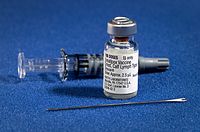
Photo from wikipedia
Quercus ilex fruit is widely used in the treatment of various gastrointestinal disorders, including diarrhea, for its bioactive compounds and astringent property. The current study focuses on the phytochemical characterization… Click to show full abstract
Quercus ilex fruit is widely used in the treatment of various gastrointestinal disorders, including diarrhea, for its bioactive compounds and astringent property. The current study focuses on the phytochemical characterization of the Q. ilex-aqueous extract (QIAE) and its protective effect against gastroduodenal (GD) ulcer (GDU) produced by absolute ethanol (EtOH) intoxication in adult male Wistar rats. Experimental rats were divided into six groups (n = 6): control, EtOH [95%, 4 g/kg body weight (b.w.)], EtOH + different doses of QIAE (100, 200, and 400 mg/kg, b.w.), and EtOH + Famotidine (FAM, 10 mg/kg, b.w.). Animals were orally pretreated (p.o.) with QIAE for 15 days and intoxicated with a single oral administration of EtOH for 2 h. The findings showed that the QIAE is rich in phenolic-astringent compounds and fibers, and it exhibited a significant scavenging activity on DPPH/ABTS free-radicals with half maximal inhibitory concentration (IC50) values of 177.00 ± 5.11 and 203.9 ± 2.23 μg/mL, respectively. In vivo part, QIAE significantly reduced the GD mucosal injury revealed by edema and leukocyte infiltration of the submucosal layer. GD mucosal homogenates revealed a remarkable increase in endogenous antioxidant enzyme activities (catalase, superoxide dismutase, and glutathione peroxidase) and a decrease in the lipid peroxidation levels (malondialdehyde) in animals pretreated with QIAE compared with the ulcer control group. QIAE exerted significant and dose-dependent anti-GDU protection in the rat model with a more effective action than FAM. The GD protective effect of the QIAE might be related to a direct radical scavenging activity, increased antioxidant enzymes, and depression of lipid peroxidation.
Journal Title: Journal of medicinal food
Year Published: 2022
Link to full text (if available)
Share on Social Media: Sign Up to like & get
recommendations!